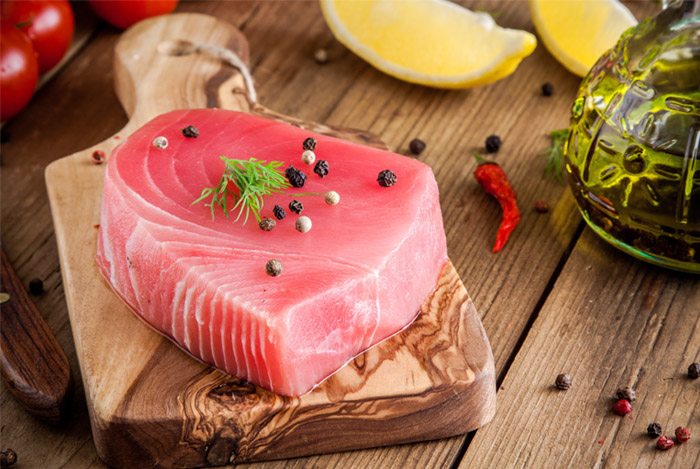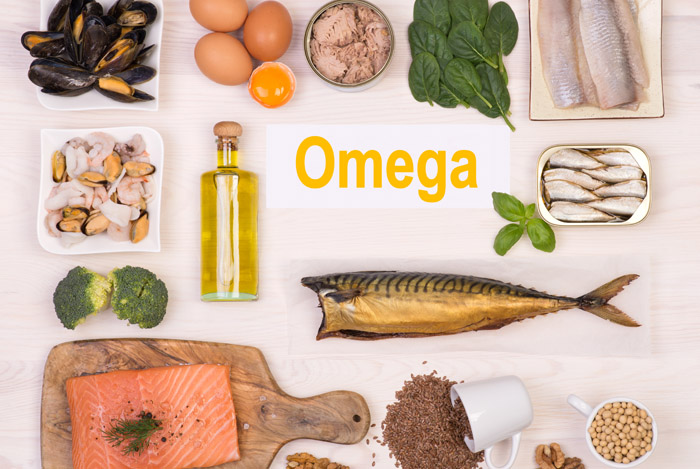Hearing all the hoopla about how healthy omega fatty acids are can sometimes feel like listening to a broken record.
I mean nutritionists love to sing odes about omega fatty acids, and I’m no exception. I must mention them in close to 80% of my posts on the blog (if not more!).
So even though we all know that omegas are amazingly healthy, do we really know what omegas are and how they work?
When omegas were first discovered in 1923, they were actually designated as a vitamin – vitamin F – before being better classified as fats in 1929.
There are three types of fats:
- Saturated
- Monounsaturated
- Polyunsaturated
Omegas happen to fall in the polyunsaturated fat category, which is under the unsaturated fat umbrella.
Early scientists probably considered vitamins more necessary than fats, but now we know that our bodies can’t function without essential fatty acids such as omegas.
Why Fatty Acids are Essential
 There’s a good reason why they call omegas essential. Our bodies need these fatty acids for everything from brain function, cell signaling, and hormone production to cardiovascular protection and immunity support.
There’s a good reason why they call omegas essential. Our bodies need these fatty acids for everything from brain function, cell signaling, and hormone production to cardiovascular protection and immunity support.
There’s evidence to suggest that omegas may protect against Alzheimer’s disease, type 2 diabetes, and even depression.
Here’s the catch, though: our bodies can’t produce these essential fatty acids on their own.
Now do you see why nutritionists are always trying to push omegas on their clients?
When you eat fat, it’s either digested and used for energy (yay!), stored in fat tissue (boo!), or assimilated into other fatty organs and tissues.
This is not a bad thing; our brains and cell membranes are fat-based, afterall.
The phrase, “You are what you eat,” has never been more true; the fat you eat literally becomes part of your cells.
Because such important parts of our bodies are being affected by the type of fat we eat, we need to make sure we’re eating the right kind of fat.
If we consume the wrong kind of fat – such as saturated fat from processed foods -it can throw off the way our cells signal events such as inflammation, pain, and blood vessel and airway constriction.
So what’s the right kind of fat?
All About Omegas 101
There are only two fatty acids that we know to be critically essential for the functioning of our bodies: alpha-linolenic acid (an omega-3) and linoleic acid (an omega-6).
What’s the difference between these two, you ask?
Omega-3
 There are over 10 different types of omega-3 fatty acids, but the most important three are recognized as:
There are over 10 different types of omega-3 fatty acids, but the most important three are recognized as:
- ALA (alpha-linolenic acid)
- DHA (docosahexaenoic acid)
- EPA (eicosapentaenoic acid)
ALA needs to be converted into the more usable, “active” forms of EPA and DHA, but this conversion process leaves a lot to be desired as only a small fraction of that ALA actually becomes usable EPA, and an even smaller percentage becomes DHA.
These conversions (while not that great to begin with) rely on the amount of nutrients such as copper, calcium, zinc, magnesium, iron, and vitamins B6 and B7, that are in your body in order for them to be successful.
However, if you’re not getting these nutrients from your diet, your conversion rate will be less successful. All of the ALA that’s not converted is stored for use by the body for energy.
Marine life such as fatty fish and algae are an abundant source of the best omega-3s, EPA and DHA. The strongest amounts of omega-3s will be found in:
The American Heart Association recommends eating at least two servings of surprisingly healthy fatty fish each week. Remember: one serving is 3.5 ounces of cooked fish.
If you already have heart disease, you should be aiming for about one gram of EPA and DHA per day by supplementing with fish oil.
Now, if you’re living that cool vegan life, you can still get your omega-3s, but you won’t be ingesting the powerful EPA and DHA like your fish-loving buddies. The omega-3s in plant sources are mostly ALA, which will need to be converted in your body.
You’ll enjoy plant-based omega-3s from:
- Nuts
- Chia seeds
- Flax seeds (and flaxseed oil)
- Hemp seeds (hemp hearts)
- Kale
- Spinach
- Soybeans
Omega-6

Linoleic acid (LA) is the essential omega-6 our bodies need, but can’t create on their own. LA is not to be confused with the omega-3 ALA.
You’ll find LA in certain nuts, seeds, meat, eggs, dairy, and plant oils such as:
- Soybean
- Corn
- Safflower
- Sunflower
- Peanut
- Cottonseed
These oils are typically used in processed foods (because they’re cheap) and deep-frying, which are both unhealthy to begin with, and may even contain genetically modified ingredients.
“Soybean oil alone is now so ubiquitous in fast foods and processed foods that an astounding 20 percent of the calories in the American diet are estimated to come from this single source.”
Since they don’t have mackerel burgers or algae fries at the drive-thru, omega-6s are more prevalent in the typical American diet than omega-3s. These popular sources of omega-6s are pro-inflammatory.
Inflammation is our immune system’s way of protecting us from infections, injuries, and bodily damage, but too much inflammation can result in the medical conditions such as cancer, heart disease, and Alzheimer’s.
Conversely, people following healthier eating plans such as the Mediterranean diet, which strongly favors omega-3-rich foods over omega-6-rich foods, are less likely to develop heart disease, type 2 diabetes, and other serious health conditions because omega-3s are anti-inflammatory.
However, not all omega-6s are bad news.
When our bodies convert linoleic acid to gamma-linolenic acid (GLA), it becomes arguably the healthiest omega-6. It’s been found to reduce inflammation where other forms of omega-6 increase it.
Unfortunately, it’s pretty hard to find GLA on its own as it’s found in plant-based oils such as:
- Black currant seed oil
- Evening primrose oil
- Borage oil
If you’re like most people, you’re probably plum out of borage oil and instead rely on the other omega-6 oils. But having too many omega-6s also harms your chances of getting enough omega-3s.
Omega-9
 Often considered the redheaded stepchild of the omega family, omega-9s are just a little bit different from omega-3 and omega-6.
Often considered the redheaded stepchild of the omega family, omega-9s are just a little bit different from omega-3 and omega-6.
For one, our bodies can actually produce omega-9 on their own.
And two, omega-9s are very high in monounsaturated fats (close to or over 70%), so they’re often just referred to as monounsaturated fatty acids.
Omega-3 and omega-6, on the other hand, are both polyunsaturated fats. Omega-3, 6, and 9 are all still unsaturated fats as opposed to saturated fats.
Did I lose anyone? This took me a while to understand my first time, too. 
Omega-9 fatty acid, also known as oleic acid, is found in animal fat and plant-based oils such as:
- Canola
- Olive
- Sunflower
- Nut oils
As you can see, these are some of the healthiest cooking oils you can use for your health.
Keeping Them All Balanced
 See, when omega-3 and omega-6 go through the conversion process in your body, they compete for the same conversion enzymes. The problem is that there’s usually more omega-6s to bully the omega-3s from being converted and used successfully.
See, when omega-3 and omega-6 go through the conversion process in your body, they compete for the same conversion enzymes. The problem is that there’s usually more omega-6s to bully the omega-3s from being converted and used successfully.
We need to perform a sort of balancing act to ensure that our body’s omega-3 conversion doesn’t get pushed aside.
Scientists are still debating the perfect ratio of omega-6s to omega-3s, but have generally agreed that aiming for a ratio that ranges from 1:1 to 4:1 is ideal.
Paleo dieters will probably tell you to stick to the low end as researchers suggest that we human beings evolved on a strictly 1:1 omega-6 to omega-3 ratio.
This is light years away from what most Americans are consuming.
“A typical North American diet may contain 11 to 30 times more omega-6 fatty acids than omega-3 fatty acids, contributing to the rising rate of inflammatory disorders in the United States.”
But don’t swear off omega-6s just yet. The American Heart Association argues that they provide important health benefits that shouldn’t be limited by a ratio.
Harvard University School of Public Health cardiologist Frank Sacks, MD, says:
“The ratio of omega-6s to omega-3s doesn’t matter since both are good. The ratio is meaningless because it’s good divided by good.”
So what does this mean for us?
I’d say it probably all depends on your health status and your lifestyle choices.
If you’re consuming most of your omega-6s in the form of harmful fast food, you should definitely try to lower your omega-6 ratio and raise your omega-3s.
But if you’re active, choosing nutritious, whole foods, and consuming most of your omega-6s via nuts, seeds, and eggs, I’d say just make sure to add more omega-3s to your diet.
So what will eating all of those omegas do for your body?
Protect Against Heart Disease
 Most people take omegas because of their reputation as superheroes for your heart.
Most people take omegas because of their reputation as superheroes for your heart.
Omega-3s have been shown to reduce overall mortality and death due to heart attacks or other sudden causes of death in patients with coronary heart disease (CHD).
One meta-analysis of studies examined the relationship between omega-containing fish consumption and CHD deaths in 222,364 participants for close to 12 years.
Researchers learned that participants had an 89% relative risk of CHD death if they ate fish just one to three times a month. Those risks dropped down to 77% for those eating fish two to four times per week, and to an incredible 62% for participants enjoying fish 5 or more times a week.
Basically, each 20 g/day “increase in fish was related to a 7% lower risk of CHD mortality.” That means you can reduce your chances of heart related death by just eating fish more than once a week.
Doesn’t sound too bad to me, but I love fish.
What about omega-6?
According to research, GLA (omega-6) may help decrease high blood pressure on its own or in conjunction with EPA and DHA (omega-3s). When men with borderline hypertension (high blood pressure) took 6 g of black currant oil (a GLA), they reduced their diastolic blood pressure.
And when six healthy male rats were fed a high-cholesterol diet, GLA supplementation reduced their total cholesterol levels, triglycerides, and even prevented LDL from oxidizing.
“LDL cholesterol, which is known as your “bad” cholesterol, becomes even more dangerous when it is oxidized. Oxidized LDL can produce inflammation in arteries that supply blood to your organs and other tissues, thus promoting atherosclerosis and increasing your risk of having a heart attack or stroke.”
Nuts, which contain both healthy omega-6s and omega-3s, may be the best omega super combo food. After analyzing four studies, researchers found that “a weekly serving of nuts lowered the risk of dying of coronary heart disease by an impressive 8.3%.”
Omega-9s are by far the best omegas. These are the healthy monounsaturated fats that increase HDL, or your “good” cholesterol, and decrease your LDL cholesterol. They also help remove plaque buildup in the arteries to reduce your chances of heart attacks and strokes.
Free Your Mind & Decrease Depression
 Having elevated levels of omega-6s has been associated with depression and even higher rates of violence.
Having elevated levels of omega-6s has been associated with depression and even higher rates of violence.
Conversely, EPA and DHA (omega-3s) have been shown to be incredibly important for our mental health.
When 28 patients with major depressive disorder were given 9.6 g/day of omega-3 with their usual treatment, they had “a significantly decreased score on the 21-item Hamilton Rating Scale for depression than those in the placebo group.”
Omega-3s have even been studied for their effective role in helping to treat bipolar disorder.
Alzheimer’s Disease and Brain Health
 As a general rule across the board, people who eat fish fish every week have been shown to have lower risks of developing dementia or other signs of brain ageing. I cannot stress this evidence enough.
As a general rule across the board, people who eat fish fish every week have been shown to have lower risks of developing dementia or other signs of brain ageing. I cannot stress this evidence enough.
Decreasing levels of DHA during aging has been linked to impaired brain function and the onset of Alzheimer’s disease.
During one trial, omega-3s were given in combination with ALA for a full year. The results indicated that this combo slowed cognitive and functional decline, which is an incredible benefit for Alzheimer’s patients.
And patients with age-related memory impairment improved their learning and memory function when they were given 900 mg of DHA per day for 24 weeks.
Lose and Keep Weight Off
 Omega-3 fatty acids keep you feeling full so you stay away from unhealthy temptations. According to one review, omega-3s reduced participants’ appetites and increased fat burning.
Omega-3 fatty acids keep you feeling full so you stay away from unhealthy temptations. According to one review, omega-3s reduced participants’ appetites and increased fat burning.
Researchers from another study gave 50 formerly obese individuals either 890 mg of GLA or 5 g of olive oil per day for one year. They noticed that subjects who received the GLA regained an average of just under five pounds, but the participants taking the olive oil placebo gained just over 19 pounds!
GLA may be helpful for reducing weight gain following major weight loss.
Final Notes
 Now do you see why nutritionists are always so eager to talk about omegas?
Now do you see why nutritionists are always so eager to talk about omegas?
We need these essential fats for our bodies to function properly and, unfortunately, most of us aren’t getting the right ratio of them. This is why inflammation is on the rise and serious medical conditions such as heart disease are so rampant.
Fat is an important macronutrient, it’s not the enemy. Once you start eating fatty fish and using healthy cooking oils instead of consuming cheaper oils found in processed foods, your body will thank you with the gift of fantastic health.
Were you surprised to learn about how many omega-6s most of us eat? Are you groaning about having to eat fatty fish every week? Share your thoughts with me in the comments – I’d love to hear what you have to say!
The post How Much Do You Know About Omegas? appeared first on Nutrition Secrets.
http://www.nutritionsecrets.com/how-much-do-you-know-about-omegas/
No comments:
Post a Comment